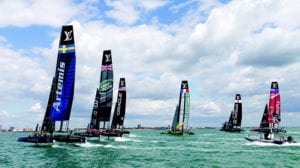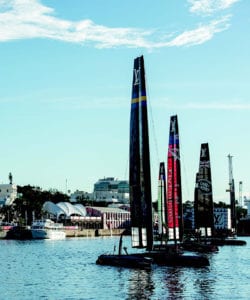Sneak Peek: America’s Cup
Get ready to set sail: the hunt for America’s Cup is on. In this sneak peek from the Spring 2016 issue of SOAR, get to know the history of the world’s oldest international sporting trophy – then, witness history being made as the competition visits New York for the first time in 96 years.
A day spent sailing is often a fond memory or relaxing pastime. But when the tides turn to competition, it’s anything but calm – especially when it comes to the America’s Cup. This winner-take-all race isn’t just another match, it’s the oldest international sporting trophy – and it draws in top-dollar investors, highly skilled athletes and dedicated fans the world over.
 America’s Cup isn’t named for the nation – it’s named for its first winner. In 1851, the schooner America – on behalf of the New York Yacht Club – bested the Royal Yacht Squadron and won their cup. Queen Victoria, watching the race, asked who was in second place, and the answer might have been a shock. “Your Majesty, there is no second,” is the famed response, and to this day that answer is held as the best description of the Cup. The schooner America won the the trophy, the idea for a challenge competition was born. Each year, only two teams compete, and the defending champion sets the rules for the next year’s event.
America’s Cup isn’t named for the nation – it’s named for its first winner. In 1851, the schooner America – on behalf of the New York Yacht Club – bested the Royal Yacht Squadron and won their cup. Queen Victoria, watching the race, asked who was in second place, and the answer might have been a shock. “Your Majesty, there is no second,” is the famed response, and to this day that answer is held as the best description of the Cup. The schooner America won the the trophy, the idea for a challenge competition was born. Each year, only two teams compete, and the defending champion sets the rules for the next year’s event.
The competition began in 1851, when Commodore John Cox Stevens and the New York Yacht Club set out to build a yacht and compete in English regattas. They bested the Royal Yacht Squadron in the annual 53-nautical-mile race around the Isle of Wight, leading to the Queen’s question – and her attendant’s infamous answer. After the New York Yacht Club won, the cup went home to New York with the ship’s ownership syndicate. The syndicate donated the trophy to the New York Yacht Club in 1857 with a Deed of Gift, dedicating the cup to a perpetual challenge.
The first challenge came in 1871, with Englishman James Ashbury racing against the New York Yacht Club’s 17-boat fleet, his Cambria finishing tenth. Displeased at the outcome, Ashbury insisted on racing only one boat in the next match in 1871 – losing again. The Royal Canadian Yacht Club and Bay of Quinte Yacht Club issued challenges and were beaten handily by NYYC.
Six more challenges were issued before 1900, and the Cup’s “Lipton Era” began. Sir Thomas Lipton, the tea baron, issued five challenges from 1899-1930, losing to defenders sponsored by J. Pierpont Morgan and Harold S. Vanderbilt’s syndicates. Lipton was recognized as a “lovable loser,” and was one of the first to introduce the idea of a sports sponsorship. His fame as a challenger, no matter the outcome, promoted his business in America.
 Though rules and challengers continued to change, the New York Yacht Club held America’s Cup until 1983, after 132 years and 26 challenges. The Royal Perth Yacht Club’s Australia II, owned by Alan Bond and skippered by John Bertrand, overtook the New York Yacht Club’s Liberty to win the Cup 4-3. The Royal Perth Yacht Club was bested by the San Diego Yacht Club in 1987, but didn’t win the Cup back until 1995. The Cup has only been won by five organizations: the New York Yacht Club, the Royal Perth Yacht Club, the San Diego Yacht Club, the Royal New Zealand Yacht Squadron and Société Nautique de Genève. BMW Oracle Racing (now Oracle Team USA) claimed the title for Golden Gate Yacht Club in 2010, and successfully defended it against Royal New Zealand Yacht Squadron in 2013.
Though rules and challengers continued to change, the New York Yacht Club held America’s Cup until 1983, after 132 years and 26 challenges. The Royal Perth Yacht Club’s Australia II, owned by Alan Bond and skippered by John Bertrand, overtook the New York Yacht Club’s Liberty to win the Cup 4-3. The Royal Perth Yacht Club was bested by the San Diego Yacht Club in 1987, but didn’t win the Cup back until 1995. The Cup has only been won by five organizations: the New York Yacht Club, the Royal Perth Yacht Club, the San Diego Yacht Club, the Royal New Zealand Yacht Squadron and Société Nautique de Genève. BMW Oracle Racing (now Oracle Team USA) claimed the title for Golden Gate Yacht Club in 2010, and successfully defended it against Royal New Zealand Yacht Squadron in 2013.
The challenges have been litigious at times: in 1988, the San Diego Yacht Club received a challenge from New Zealand’s Mercury Bay Boating Club before official terms for the regatta were announced. The two clubs fought in court over the terms of the race, as the San Diego group planned to race with 12-metre yachts and the challenger with the “Big Boat,” boasting a 90-foot waterline and the largest single-masted yacht allowed under the original rules of the Deed of Gift. The New York State Supreme Court ruled that the challenge was valid, and that SDYC had three choices: negotiate mutually agreeable terms, race under default provisions of the Deed or forfeit.
As the America’s Cup technology continues to advance and the races become faster and more daring, the element of danger in the regatta has risen. Andrew Simpson, British citizen and a two-time Olympic medalist, was training with Artemis Racing on San Francisco Bay in 2013 in advance of the 34th America’s Cup. The boat, sponsored by the Royal Swedish Yacht Club, tipped and trapped Simpson underwater for at least 10 minutes: he was declared dead after 20 minutes of CPR at the scene. The previous October, Oracle’s AC72 capsized, damaging the boat’s multi-million-dollar sail. Articles with titles like “Billionaire death race” asked the question no one wanted to answer: “Is it too fast to be safe?” Simpson was the second death in the history of the Cup, and his loss shook the sailing community.
The Louis Vuitton America’s Cup World Series is using the AC45, a smaller version of the AC72. The AC45 supports a crew of 5 plus one guest.

Contact Us